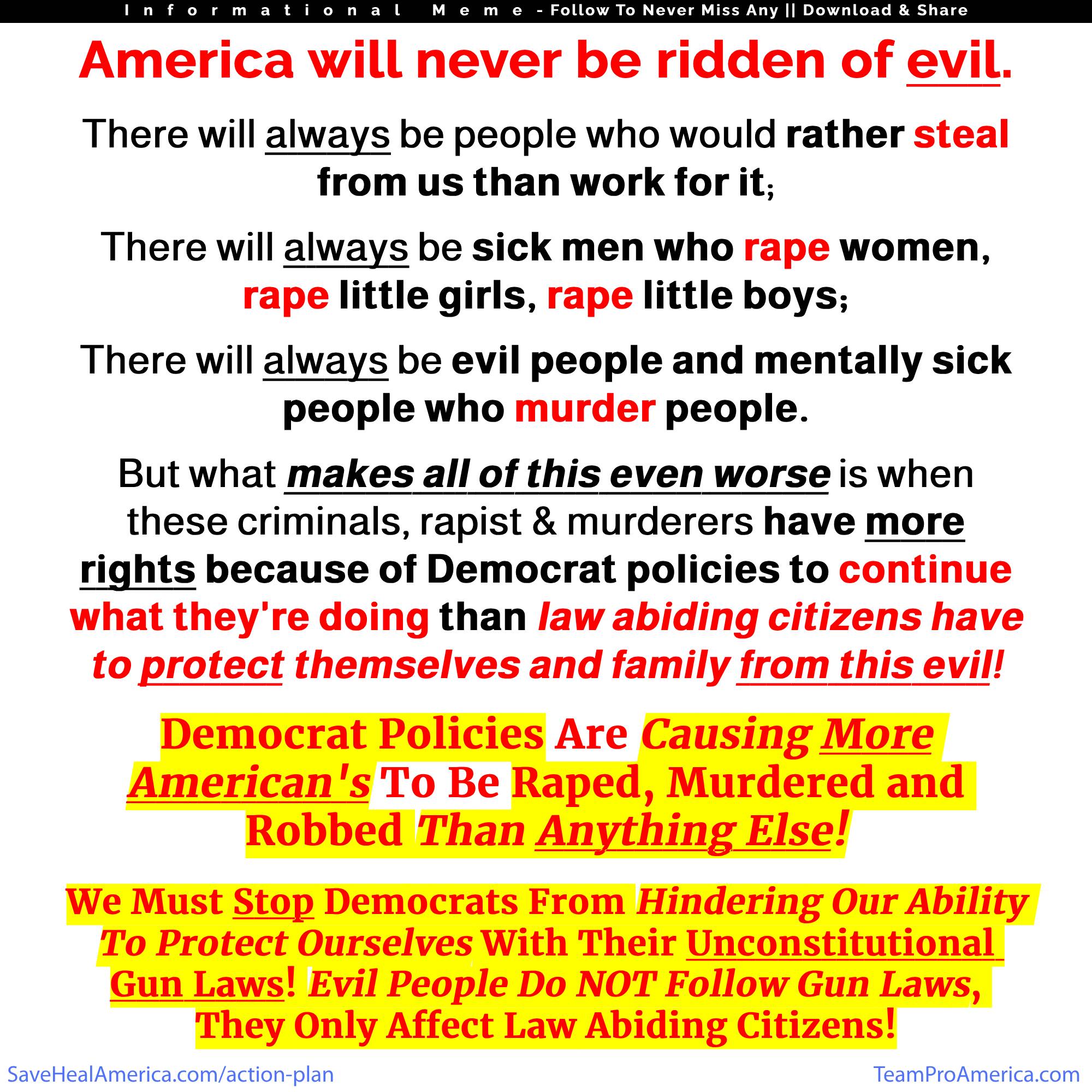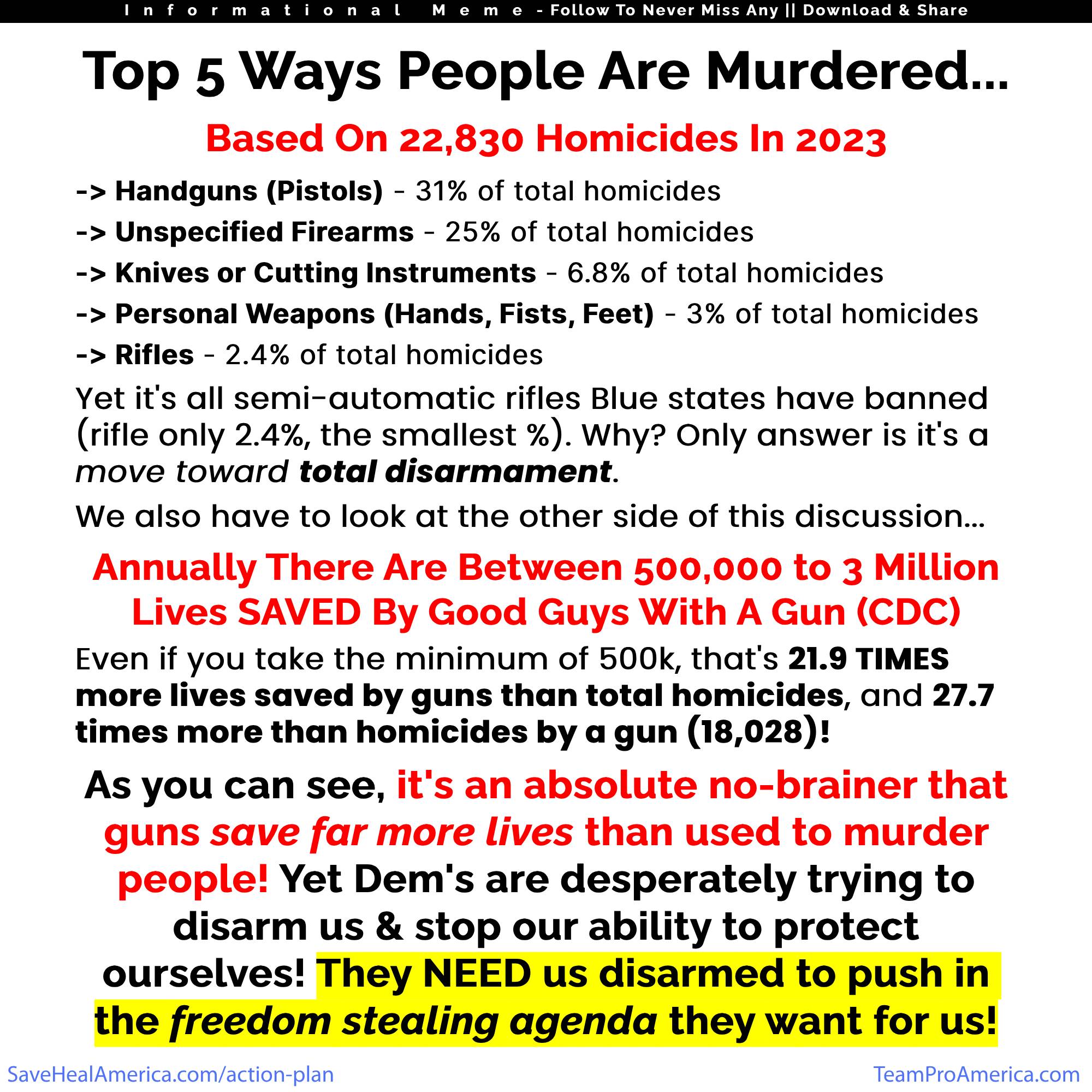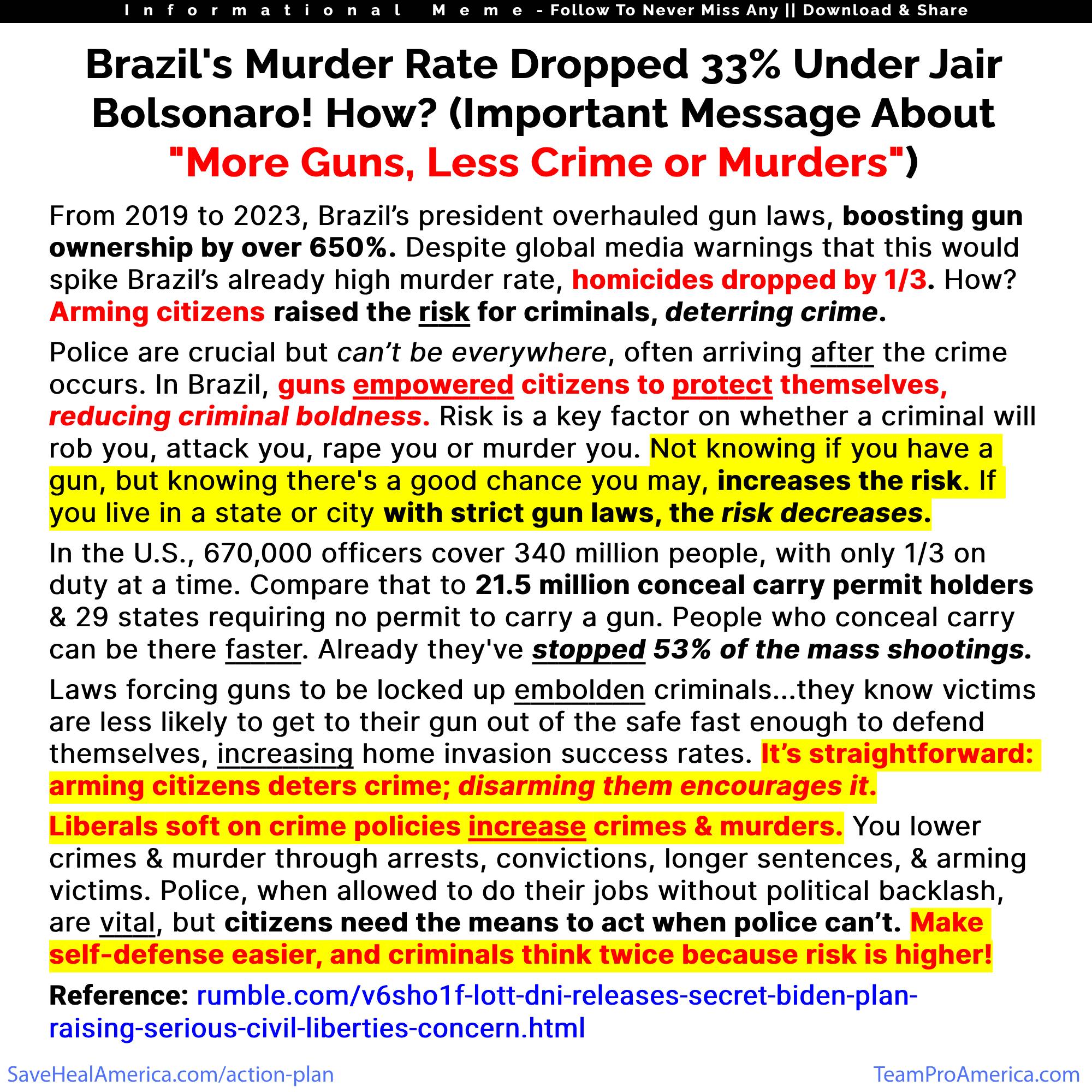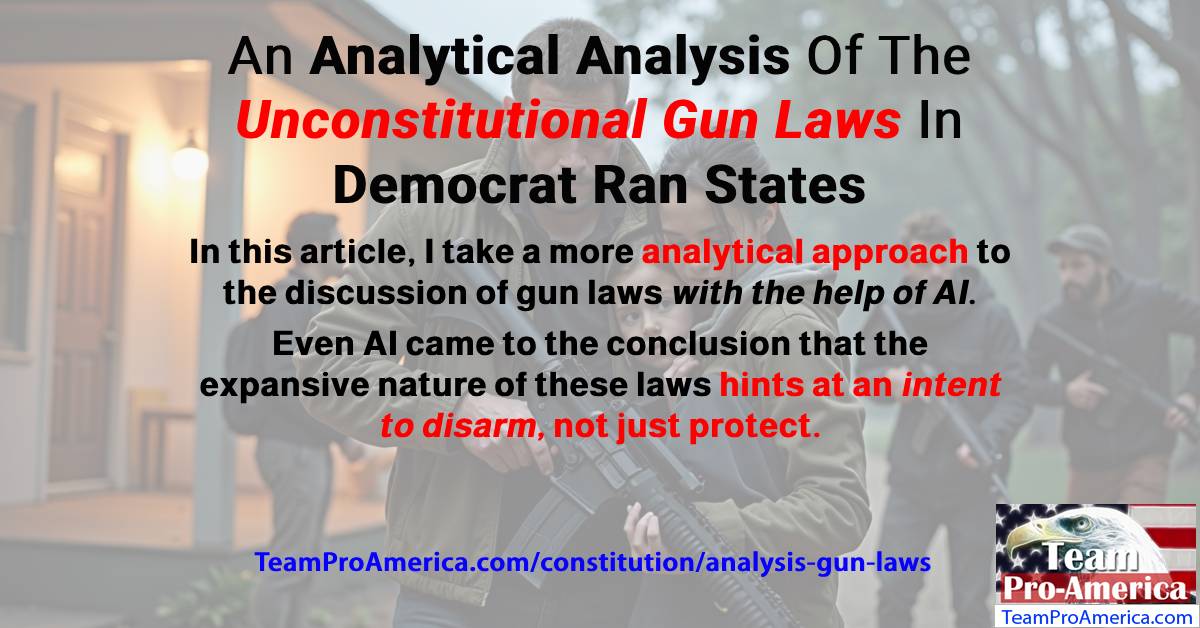Last Updated: 0/0/25 (Jump down to New/Additional Information)
An Analytical Analysis Of The Unconstitutional Gun Laws In Democrat Ran States
In my first major article on gun laws and how Democrat ran states are passing unconstitutional gun laws which are infringing on our constitutional rights (We All Have The Right To Defend Ourselves But Democrats Continue To Make That Much Harder), I approached it like an every-day person who does a deep dive into this topic looking at the ridiculous gun laws Democrat ran states have been passing.
I broke that article into 5 logical parts addressing the key areas that must be considered when looking at the gun laws Democrat ran states are passing.
In this new article, I take a more analytical & methodical approach to this discussion with the help of AI. Using AI, it provided a whole new look at these gun laws, and revealed even more factual information which goes completely against these gun laws the Blue States are passing! Let's dig in...
More...
Challenging the Anti-Gun Narrative: A Constitutional and Practical Critique of Gun Control Laws
Introduction
In states like Washington, where Democrat-led legislatures have enacted a flurry of gun control laws—such as the assault weapons ban (HB 1240, 2023), high-capacity magazine ban (SB 5078, 2022), and proposed permit-to-purchase requirement (HB 1163, 2025)—proliferate, igniting debate over their clash with constitutional rights and efficacy in enhancing public safety.
Anti-gun advocates argue these measures are essential to curb gun violence, pointing to mass shootings, suicides, and domestic abuse as justification.
Yet, this narrative falters under scrutiny: these laws may infringe the Second Amendment, impair Washington’s Article I, Section 24, fail to address violence’s root causes, and dismiss armed citizens’ protective role—all while risking liberty itself.
This article challenges the anti-gun narrative with evidence, legal analysis, and practical alternatives, focusing on Washington as a case study while questioning whether the intent behind such expansive restrictions is truly about safety—or something more.
Are the expansive restrictions masking a government control agenda rather than a safety solution?
Constitutional Concerns
Gun laws face a high constitutional bar, especially in Washington.
Washington’s Constitution, Article I, Section 24, declares: "The right of the individual citizen to bear arms in defense of himself, or the state, shall not be impaired..."
Article I, Section 24 states: "The right of the individual citizen to bear arms in defense of himself, or the state, shall not be impaired..." Broader than the Second Amendment’s "shall not be infringed," "impaired" guards against any diminishment, triggering strict scrutiny: a compelling interest and narrow tailoring. Laws like HB 1240, which bans semi-automatic rifles (e.g., AR-15s, owned by millions for self-defense), and HB 1163, which proposes a permit with training and background checks for all firearm purchases, impair this right.
The U.S. Supreme Court’s Bruen decision (2022) mandates historical tradition, yet no 1791 or 1868 analogues exist for banning entire firearm classes or imposing universal purchase barriers, casting doubt on their constitutionality.
Moreover, the Second Amendment’s militia clause ties gun rights to a citizen’s role in resisting tyranny, a purpose echoed in Washington’s “defense of the state” language—restrictions like these will weaken this check against government overreach, a core constitutional intent.
Heller (2008) and McDonald (2010) affirm self-defense, while the Second Amendment’s deeper aim—resisting tyranny—echoes in Washington’s framers’ intent. These laws threaten this dual purpose, exceeding reasonable regulation (e.g., City of Seattle v. Montana, 1996) by broadly burdening law-abiding citizens, not just risks.
Anti-gun advocates argue these are permissible regulations, citing Heller (2008)’s allowance for "longstanding prohibitions." However, banning an entire class of popular firearms or imposing universal permit requirements exceeds the narrow scope of reasonable regulation upheld in Washington precedents (e.g., City of Seattle v. Montana, 1996).
The cumulative effect of Washington’s laws—layering bans, magazine limits, and permits—creates a de facto erosion of the right, impairing its exercise far beyond what courts have historically tolerated. This overreach threatens not just self-defense but the foundational liberty enshrined in both constitutions (Federal & Washington's). Such overreach burdens law-abiding citizens, not just specific threats, suggesting a constitutional violation under Washington’s broader "impair" standard.
Addressing Anti-Gun Reasons for Gun Laws
The anti-gun side justifies these laws by citing mass shootings, suicides, domestic violence, and a general need for public safety. Each reason warrants scrutiny.
- Mass Shootings
- Anti-Gun Claim: Laws like HB 1240 and SB 5078 reduce mass shootings, pointing to incidents like Uvalde (2022).
- Data: Mass shootings account for less than 1% of U.S. gun homicides (e.g., 467 deaths in 2021 vs. 20,958 total, per FBI and Gun Violence Archive). Studies (e.g., Rand Corporation, 2021) show inconclusive evidence that assault weapon bans significantly curb these events, with many involving handguns, not rifles. Defensive Gun Use (DGU) estimates of 500,000 to 3 million annually (NCVS, Kleck studies) include cases like the 2022 Indiana mall shooting, where an armed citizen stopped a mass shooter. DGU far exceeds lives saved over homicides.
- Legal Analysis: Banning semi-automatic rifles impairs self-defense under Article I, Section 24, as they are "in common use" (Heller). Bruen’s historical test finds no precedent for such bans, weakening their legal footing.
- Practical Alternative: Enhance armed security in vulnerable areas (e.g., schools, as in Texas post-Uvalde) or allow vetted concealed carry, leveraging DGU without broad restrictions.
- Here's a video discussing a study that shows civilians carrying a gun stop active shooters better than the police, and stop a large portion of these shootings: Lott: Concealed Carriers Stop active Shootings Better Than Police
- Intent Question: The emotional focus on rare mass shootings may mask a broader intent to disarm citizens, as HB 1240’s sweeping ban goes beyond targeting specific risks.
- Suicides
- Anti-Gun Claim: Waiting periods (HB 1143) and secure storage (HB 1152) cut suicides, which dominate Washington’s gun deaths (69% of 935 annually).
- Data: Japan (14.7 suicides per 100,000) and South Korea (28.6) outpace the U.S. (13.7, WHO 2020) despite near-total gun bans, showing method substitution (e.g., hanging). Studies (e.g., American Journal of Public Health, 2015) find waiting periods have mixed effects, often offset by other means.
- Legal Analysis: Requiring locked storage or delays impair immediate self-defense access under Article I, Section 24. Heller rejected inoperable firearm mandates, suggesting similar constitutional issues.
- Practical Alternative: Boost mental health resources (e.g., Washington’s 988 lifeline), addressing the root cause more effectively than gun laws.
- Intent Question: Overemphasizing suicides to justify universal restrictions (e.g., HB 1152) hints at a goal of reducing gun ownership broadly, not just preventing self-harm.
- Contradiction: It needs to be addressed that Washington state supports "assisted suicides". This contradict any arguments the state would have on suicides as a whole.
- Domestic Violence
- Anti-Gun Claim: Red flag laws and background checks prevent domestic violence deaths (1,500 annually, FBI), upheld by Rahimi (2024).
- Data: Domestic violence homicides are 7% of U.S. gun deaths, mostly with handguns, not rifles banned by HB 1240. Red flag laws show modest impact (e.g., 7.5% reduction in Indiana, Journal of Interpersonal Violence, 2021), while existing background checks already screen abusers.
- Legal Analysis: Rahimi supports narrow disarming of abusers, but broad laws like HB 1163’s permit requirement impair all citizens’ rights under Article I, Section 24, lacking historical precedent.
- Practical Alternative: Enforce restraining orders and improve victim support (e.g., shelters), targeting abusers without blanket restrictions.
- Intent Question: Extending controls to all owners suggests an intent beyond domestic safety, possibly aiming to limit gun access generally. A woman unable to quickly purchase a gun has been the cause of many women murdered by their ex... waiting periods are dangerous!
- Accidental Shootings
- Anti-Gun Claim: Storage laws (HB 1152) and training (HB 1163) reduce accidents (e.g., 486 U.S. deaths, CDC 2020).
- Data: Accidents are 1.2% of gun deaths; states with high ownership (e.g., Montana) have lower rates than restrictive ones (e.g., New York, CDC). Training’s effect is unproven (JAMA, 2018).
- Legal Analysis: Mandates impair instant self-defense (Article I, Section 24), echoing Heller’s rejection of inoperability.
- Practical Alternative: Promote voluntary education (e.g., NRA programs), avoiding mandates. K-12 schools could offer gun safety classes if this is a real concern as a far better solution.
- Intent Question: Minor risk (1.2% of gun deaths) doesn't justify broad rules, hinting at control over safety.
- Gun Trafficking
- Anti-Gun Claim: Dealer rules (HB 2118) and purchase limits (HB 1132) stop trafficking (e.g., 10,000 guns traced to crime, ATF 2020).
- Data: Most trafficked guns come from theft or straw purchases (ATF), not legal sales HB 2118 targets. Limits ignore black market sources (80% of crime guns, DOJ 2021).
- Legal Analysis: Burdening legal buyers impairs rights (Article I, Section 24) without historical precedent (Bruen).
- Practical Alternative: Crack down on theft and illegal markets, not lawful owners.
- Intent Question: Regulating legal channels while ignoring illicit ones suggests ownership reduction.
- Youth Violence
- Anti-Gun Claim: Bans and storage curb youth deaths (e.g., 2,500 under 18, CDC 2020).
- Data: Most youth deaths are homicides in urban gangs (80%, CDC), not rifle accidents HB 1240 targets. Storage laws show no clear drop (J Pediatrics, 2020).
- Legal Analysis: Broad bans impair adult rights (Article I, Section 24) without historical basis (Bruen).
- Practical Alternative: Address gang violence via policing and youth programs.
- Intent Question: Using youth as a lever for wide laws points to disarmament.
- Public Safety
- Anti-Gun Claim: Comprehensive laws reduce gun violence, citing the U.S.’s 12.2 gun deaths per 100,000 (CDC 2020).
- Data: Murder rates dropped from 9.8 (1991) to 5.0 (2019, FBI) as gun ownership rose by 170 million (ATF). High-gun states like Wyoming (1.5 homicides per 100,000) fare better than restrictive California (5.7, FBI 2020). Gun-free zones (92% of mass shootings, 1998–2018, CPRC) increase vulnerability.
- However, Washington's murder rate increased from 2.8/100k in 2012 to 5.0/100k in 2022. What changed? In 2012 progressives Inslee & Ferguson got into office and started pushing progressive policies, which have shown to increase crimes, murders, and rapes in the Democrat ran cities they have been pushed in.
- Legal Analysis: Cumulative restrictions impair self-defense under Article I, Section 24, beyond reasonable regulation, with no historical basis (Bruen).
- Practical Alternative: Target repeat offenders (most homicides, FBI) and fund community safety programs, preserving citizens’ protective role.
- Intent Question: The rapid, broad scope of laws (e.g., 2022–2025 in Washington) suggests a disarmament agenda, not just safety.
Here's a video presenting how Blue states are "using" public safety to strip us of our gun rights saying many of the same things I've been saying of how it's all just a strategy to work toward taking away our guns, tax us more and take away more of our freedoms...
Practical and Data-Driven Critique
The anti-gun case unravels further with broader evidence. High-ownership states often have lower crime, and DGU (500,000–3 million) dwarfs homicides (17,000, FBI 2019). Gun-free zones, like those proposed in SB 5098, leave citizens defenseless, contradicting safety claims.
Non-compliance is rampant: over 60% of Washington counties are "Second Amendment sanctuaries" (2023), with sheriffs refusing enforcement (e.g., Klickitat County Sheriff’s statement, 2023), rendering laws ineffective. These are sheriffs who see these laws for what they are: unconstitutional laws which infringe (and impair) the citizens ability to defend themselves and are ultimately meant to move toward disarming the citizens.
Rifles, targeted by HB 1240, account for just 3% of homicides (FBI 2020), exposing misplaced focus. These laws impair the practical ability to deter and stop crime, a benefit anti-gun advocates ignore.
Unintended Consequences and Emotional Appeals
Anti-gun laws backfire, a point their emotional appeals—grieving families, tragic headlines—obscure.
Disarming law-abiding citizens leaves rural areas, where police response averages 20+ minutes (DOJ, 2021), vulnerable to home invasions (1.5 million annually, FBI).
Gun bans fuel black markets: post-1996, Australia saw illegal gun seizures rise 50% (UNODC, 2020). Youth gang recruitment thrives where legal protection wanes (Criminology, 2019).
Emotions drive the anti-gun fervor, but data shows their laws may worsen safety for the very people they aim to protect, a contradiction they rarely confront.
Countering Anti-Gun Propaganda
Anti-gun propaganda—relentless media loops of tragedy, skewed stats (e.g., conflating suicides with homicides or including 18-19 year olds who are legal adults in their gun stats on children), and vilification of gun owners—swamps public perception, as 78% of Americans overestimate gun violence’s scope (Gallup, 2023).
Funded by groups like Everytown ($50M annually, FEC 2022), it drowns out facts: like how 70% of gun deaths are suicides or gang-related (CDC), not mass shootings.
Regarding the 70% of gun deaths from suicide, you also don't hear about other gun-free countries that have a much higher suicide rate than America and how they use other methods to commit suicide. This shows that people will always find a way if they want to kill themselves. The point is, attacking guns to try and reduce the suicides will not work.
There's also Hollywood’s anti-gun bias (e.g., 90% of firearm portrayals as criminal, UCLA 2021) fuels fear, not reason. People forget that Hollywood's job is to entertain us, not educate us. You can't accept what you see in movies regarding guns as any kind of truth.
When you consider these points, you can see how the citizens are misled to believe things that are not true. This, unfortunately, makes it harder to show people how disarming the citizens would do far more damage and would massively increase crimes, murders, and rapes than by allowing citizens to exercise their constitutional 2nd Amendment rights.
However, if you compare cities with strict gun laws to cities that follow the Constitution with reasonable gun laws, including Constitutional Carry, you see a very clear difference showing you that the cities with the strict gun laws have by far the most crime, murders, and rapes!
Very seldom do you hear about the good guy with a gun stopping a bad guy from killing people. Yet, there are 17,000 homicides a year compared to 500,000 to 3 million times a year a good guy with a gun defends himself, his family or others like the guy who took out the mass murderer at the Indiana Mall in 2022. In my previous article I have a whole section on good guys with a gun because this side of the discussion also needs to be shared.
The stories around good guys with a gun just aren't shared so the average citizen wouldn't know all of this.
The Slippery Slope and Societal Cost
Gun laws risk a slippery slope toward broader disarmament. Historical disarmament—Nazi Germany (1938), Soviet Union—preceded tyranny, a warning echoed by 72% of Americans valuing guns for protection (Pew, 2021).
Washington’s incremental laws could normalize further erosion, weakening the Second Amendment’s anti-oppression role and Article I, Section 24’s liberty shield. Societally, disarming citizens fosters government dependence, which is a problem in Washington due to their 'defund the police' movement and anti-police sentiment by the legislature, which has caused hundreds of police to leave the force and not being able to meet recruitment goals.
Lack of police makes the citizens less safe. Add to this the citizens being impaired from self-protection, which is eroding self-reliance—America’s bedrock.
Economic costs mount too: gun industry jobs (150,000+, NSSF 2023) and tax revenue ($9 billion) suffer under restrictive policies, a hidden toll.
Anti-gun intent may prioritize state power over individual agency, a cost unaddressed by safety claims.
Addressing the Control Narrative
The scope of Washington’s laws fuels suspicion. Why ban rifles when they are rarely used in crime (rifles: 3% of homicides, FBI 2020), or impose universal permits when existing laws screen risks?
Why target legal owners when 80% of crime guns are illicit (DOJ 2021)?
The 2022–2025 legislative blitz, paired with historical parallels, fuels suspicion of a control agenda, shifting power from citizens to the state. This undermines the anti-gun safety rationale when data and alternatives offer less invasive paths.
Historical patterns and rapid legislative pace (2022–2025) suggest a goal beyond safety: reducing gun ownership to shift power dynamics. While not conclusive, this intent questions the anti-gun side’s public safety rationale, especially when data and alternatives offer less invasive paths.
Conclusion
Washington’s gun laws and the anti-gun agenda they represent violate Article I, Section 24 by impairing the right to self-defense, failing to effectively address violence’s root causes, and dismissing the safety benefits of armed citizens.
Data exposes their flaws, legal analysis their overreach & questions their constitutionality, and practical alternatives their redundancy while offering targeted solutions.
Urban bias compounds the error, emotional appeals cloud it, and control motives taint it. Anti-gun advocates must reckon with this: their laws endanger more than they protect, trading freedom for illusion.
The expansive nature of these laws hints at an intent to disarm, not just protect. Readers should scrutinize these measures’ effectiveness and support challenges like Gator’s Custom Guns v. Ferguson (pending Washington Supreme Court ruling) and demand policies balancing safety with rights—not government control masked as protection. Liberty and self-reliance hang in the balance.
Public safety is a shared goal, but it demands evidence-based policies that respect constitutional rights, not broad restrictions driven by emotion or control which is what we're currently seeing.
If the proven data here and the practical alternatives don't reverse the course of states who are aggressively pushing gun laws to give us back our gun rights as our founding fathers intended, it leaves only one conclusion: It's not about public safety, but about moving toward disarming the citizens. No other conclusion can be made.
Remember...

Here AI and I did an quick analysis of the top 5 ways people are murdered. Then we addressed how many lives are saved by Good Guys With A Gun showing how guns save more lives than they take...

How President Bolsonaro of Brazil dropped their murder rate by 33%, and comparisons to America...

If you haven't read my first article on how Blue States are infringing on our 2A rights, jump over and read it now: We All Have The Right To Defend Ourselves.
New/Additional Information:
Header
Content
